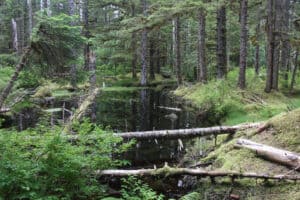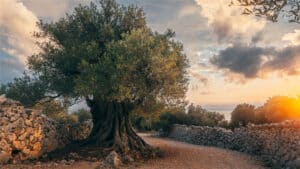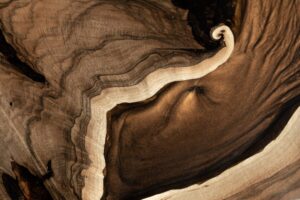The Ginkgo biloba is also known as the maidenhair tree, and it’s the last surviving tree of its type. It’s native to China, it lives a long time, and it might be extinct if it wasn’t highly cultivated by humans. We’ll look at the oldest ginkgo tree in the world and discuss important details about it.
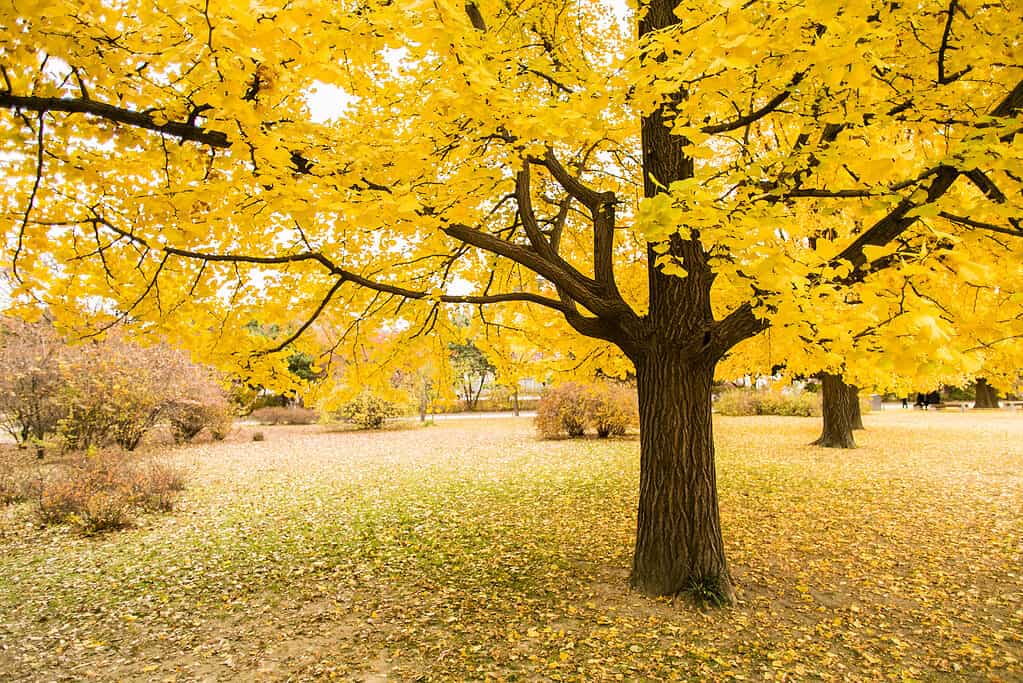
Gingko trees are also known as maidenhair trees.
©atk work/Shutterstock.com
The Oldest Living Ginkgo Tree in the World
The oldest living ginkgo tree in the world is the Li Jiawan Grand Ginkgo King. It is located in Lebang Village in western China. It’s believed to be a bit over 4,000 years old though this may be off by about 500 years in either direction.
Li Jiawan Grand Ginkgo King grows at an elevation of around 4,200 feet and it’s almost 100 feet tall. It’s considered the largest ginkgo tree on earth. It’s surrounded by low-lying crops in a valley, and it’s a male tree.
The Trunk
While the oldest ginkgo tree in the world as a whole has existed for millennia, the trunk segments are of different ages. The initial trunk was a result of the original sprout, and since then, other trunks have sprouted from the base of the tree. There have been at least 5 generations of trunks sprouting since the tree’s original appearance.
The tree has been struck by lightning a few times and a storm in July 1991 severely damaged one of the trunks. A big portion of the affected trunk was pruned, but the trunk isn’t regenerating as fast as expected. New growth on the tree as a whole is also slowing down, which suggests the tree may die in the next century or so.
The Cavity
There is a large hollow cavity in the middle of Li Jiawan Grand Ginkgo King that’s over 100 square feet in size. It’s burned inside the cavity which was most likely caused by a lightning strike that ignited a dead tree core. For 2 years in the 1970s, this hollow was home to Pan Shexiang and his cattle.
It’s not uncommon for ancient hollow trees to play host to human activities. Pre-historic humans regularly used them for shelters and Victorians held dinner parties in famous hollow trees. Most long-lived hollow trees have some kind of story or legend that suggests that someone once lived in them.
The Oldest Fossilized Ginkgo in the World
The oldest fossilized ginkgo remains ever found were more than 200 million years old. The ginkgo tree is considered a living fossil because it has hardly changed since its early days. Ginkgos were alive at the same time that dinosaurs roamed the world.
These types of trees came into existence during the Middle Jurassic and started declining in the Cretaceous. By the end of the Pliocene, all but today’s one extant species in China were gone. Fossilized evidence of ginkgo has been found on every continent.
Ginkgo trees are believed to be the evolutionary link between today’s conifers and ferns. This is surprising because ginkgo trees are deciduous. Even so, ginkgos are considered coniferous trees though they aren’t true conifers.
Female Gingko Trees Stink
Ginkgo trees smell when their ovules fall off of female trees in autumn and rot on the ground. An ovule resembles an apricot and isn’t a seed or a fruit though it’s similar to both. It has a fleshy outside and a small internal core about the size of a pistachio.
It’s believed that the rotting outer shell of these ovules attracts animals that ginkgo relies on for dispersal. Some scientists believe that most of the animals that were attracted to this smell are now extinct. Animals like dogs, squirrels, and other rodents are still drawn to them despite how they smell to humans.
To avoid the stench of ginkgo trees, most cities plant males exclusively as they do not produce ovules. Legitimate nurseries will also only sell males to the average buyer. Female trees do not produce ovules until they’ve aged about 20 years.
Why Ginkgo is Called the Maidenhair Tree
The maidenhair tree gets its name because its leaves are similar to the leaflets found on the maidenhair fern. However, it isn’t closely related to the maidenhair fern.
The maidenhair fern grows in warmer and wetter environments than the ginkgo tree. It’s also much smaller and is often for sale as a common houseplant.
Both the maidenhair tree and the maidenhair fern have historically been used for medical reasons though most of these claims are unsubstantiated. Do not use any unregulated plant or plant extract for medicinal purposes without first consulting your doctor.
Ancient Chinese medicine uses ginkgo ovule cores while western medicine claims ginkgo leaves are beneficial. Maidenhair ferns were used by westerners as a stimulant, snake bite cure, and cough suppressant around the sixteenth century. Today, ginkgo is used in a variety of foods around the world including ginkgo nut congee.
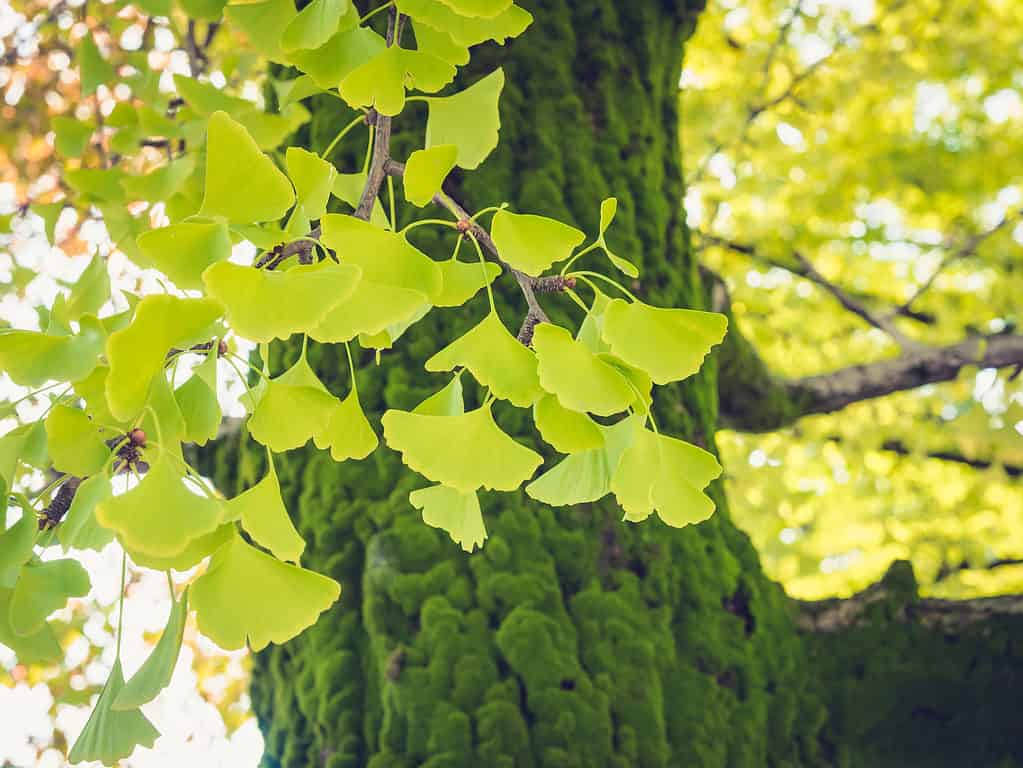
Gingko trees are also called maidenhair trees due to the leaves, which are similar to the leaflets found on the
maidenhair fern.
©VTT Studio/Shutterstock.com
Why Ginkgo Trees Are So Old
Some ginkgo trees are so old because they’re resistant to pollution, diseases, and pests. They’re extremely hardy and some ginkgo trees even survived the Hiroshima atomic bombing. As they age, their ability to remain hardy doesn’t weaken.
They’re extremely tolerant of cold and snowy weather. They also grow slowly which is correlated to extended life in other tree species. Salt levels do not need to be steady nor within a small range for a ginkgo tree to thrive.
They aren’t affected much by air pollution which aids in their suitability for urban environments. They’re common in many Chinese and Japanese cities and they have prominent places in botanical gardens around the world. In New York City, they are the most widely planted tree.
Despite their hardiness, they are susceptible to drought and undergo leaf scorching in extremely dry and hot conditions. When under this kind of stress, they are more likely to succumb to infectious bacteria carried by traveling insects.
Where Is Lebang Village, Guizhou, China Located on a Map?
The Li Jiawan Grand Gingko King is in a remote rural valley in western China near the Lebang Village in the province of Guizhou. The coordinates of the tree are: 26°39’00.0″N 107°25’00.0″E
The photo featured at the top of this post is © jessicahyde/Shutterstock.com
Thank you for reading! Have some feedback for us? Contact the AZ Animals editorial team.



